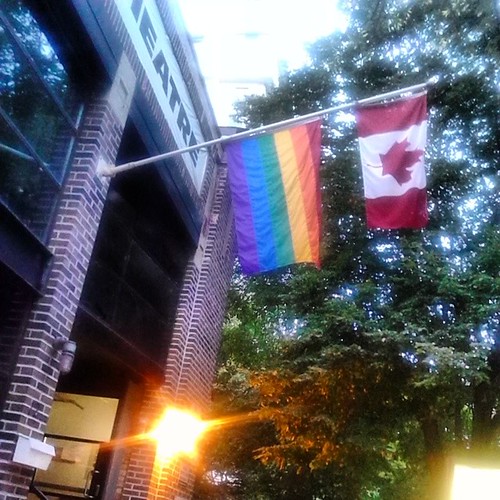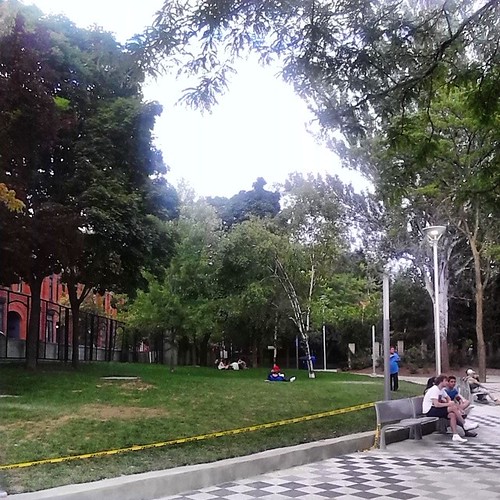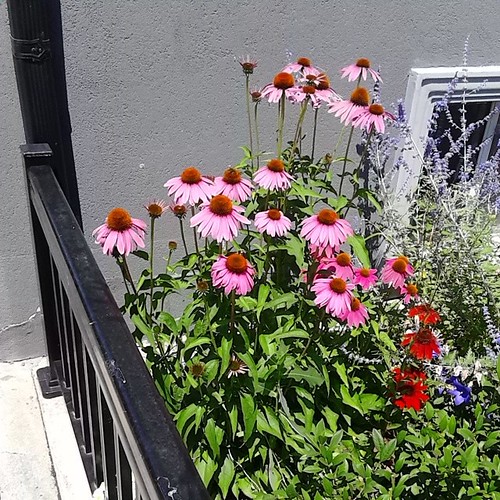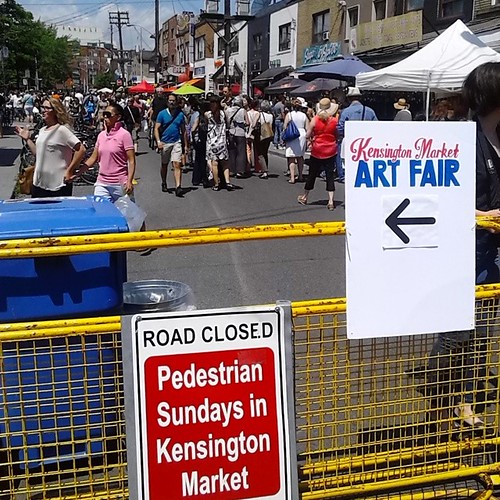- The City of Montréal is now following Québec provincial laws on flag displays, requiring the Québec flag to be flown most prominently alongside the Canadian and Montréal flags. CTV News reports.
- Former Toronto city councilor Betty Disero is now mayor of Niagara-on-the-Lake. The Toronto Star reports.
- CityLab reports on how the famously conservative Texas city of Fort Worth is now learning towards the Democratic Party.
- VICE takes a look at the reasons for the very high overdose rate among users of illegal drugs in the Scottish city of Dundee.
- Guardian Cities has a nice photo essay looking at some of the new green roofs in the Chinese city of Shenzhen.

I visited IKEA's Etobicoke store yesterday with my visiting parents, down at Kipling and Queensway not far from the Gardiner. There, the Swedish flag was flying proudly alongside the flags of Ontario and Canada.
By happy coincidence, yesterday happened to be Gustavus Adolphus Day, an event commemorating the Swedish king of that day celebrated in the former realms of the Swedish empire.
- Building two thousand affordable housing units in Toronto is a nice step forward. Will there be more steps? The Toronto Star reports.
- This charming bit of improvised art down at Humber Bay Park reminds me that I really need to head down there. From the Toronto Star.
- Montréal has stopped representing genocidal General Amherst on its flag, replacing it with a native pine tree. The National Post reports.
- Emily Macrae at Torontoist suggests co-housing, drawn from a Québec model, is something Toronto might want to look into.
- Richard Longley at NOW Toronto explores the Toronto Islands. Do they have a future? What will they need?

This flag of Prince Edward Island was waving above the parking lot of Cavendish's Avonlea Village.
The flag has the proportions 2:3; the three sides away from the mast are bordered by alternating bands of red and white.
The upper third of the flag features the English heraldic lion which appeared both on the coat of arms of Prince Edward, Duke of Kent, for whom the province is named, and on that of King Edward VII. The lower two-thirds show an island on which appear three small oak saplings (on the left) – representing the three counties of PEI (Prince, Queens, and Kings) – under the protection of a great oak tree which represents Great Britain. This symbolism is also reflected in the provincial motto, Parva sub ingenti (the small under the protection of the great).
Based upon the Armorial Bearings of Prince Edward Island, the flag contains a gold Heraldic Lion which also appeared on the Coat of Arms for Prince Edward, Duke of Kent (for whom the Province was named) and on that of King Edward VII, who granted the Bearings. Beneath the lion is a single plot of grass representing PEI and England, both of which are islands. Upon the mound of grass stand a mature Oak tree (the official tree of Prince Edward Island) which represents England and three smaller saplings on the left, representing the 3 counties into which Prince Edward Island has been divided since 1767. Framing the flag on the three sides away from the mast are alternating bands of red and white, the official colors of Canada.
The flag was adopted on March 24, 1964.
The National Post has a feature from Graeme Hamilton noting the controversy associated in Québec with the flag of the Patriote rebels of 1837.
On May 22, as the rest of Canada celebrates Victoria Day, Quebecers will get a day off in honour of les Patriotes, the 19th-century rebels who fought to bring responsible government to what is now Quebec. It’s no surprise that the mostly French-speaking province isn’t terribly keen on paying tribute to a long-dead British monarch, and such Patriote leaders as Louis-Joseph Papineau, Jean-Olivier Chénier and Wolfred Nelson are worthy of celebration. Yet last week, Quebec’s Liberal government angered nationalists by blocking a proposal to have the Patriote flag fly above the legislature in Quebec City.
Q: Who were the Patriotes?
Charles Alexander Smith via Wikipedia
Charles Alexander Smith via Wikipedia"Assemblée des six-comtés", a painting depicting the Assembly of the Six Counties, held in Saint-Charles, Lower Canada on October 23 and October 24, 1837
A: The Patriotes was the name given to Papineau’s Parti canadien and the popular movement he and others inspired to rise up against British colonial rule in 1837-38. “The primarily francophone party, led mainly by members of the liberal professions and small-scale merchants, was widely supported by farmers, day-labourers and craftsmen,” the Canadian Encyclopedia says. They advocated democracy and the right to self-government, but at the same time they were in no hurry to get rid of the seigneurial system. After the rebellion was crushed, many participants were imprisoned, exiled or hung.
Q: What is the Patriote flag?
A: The flag was introduced in 1832 by Papineau’s political party and was carried at political speeches and into battle during the rebellion. It is a simple design consisting of three horizontal bars, green, white and red from top to bottom. The flag was seen by the Montreal aristocracy as a revolutionary symbol, and in 1837 the Montreal Herald wrote urging people to destroy it. Some early versions also featured a beaver, a maple leaf or a maskinonge fish. Today, the flag often has the profile of a musket-toting, toque-wearing, pipe-smoking rebel superimposed in the centre.

This is the best picture I ever took of the flag of Prince Edward Island, adopted in 1964.
The upper third of the flag features the English heraldic lion which appeared both on the coat of arms of Prince Edward, Duke of Kent, for whom the province is named, and on that of King Edward VII. The lower two-thirds show an island on which appear three small oak saplings (on the left) – representing the three counties of PEI (Prince, Queens, and Kings) – under the protection of a great oak tree which represents Great Britain. This symbolism is also reflected in the provincial motto, Parva sub ingenti (the small under the protection of the great).
Based upon the Armorial Bearings of Prince Edward Island, the flag contains a gold Heraldic Lion which also appeared on the Coat of Arms for Prince Edward, Duke of Kent (for whom the Province was named) and on that of King Edward VII, who granted the Bearings. Beneath the lion is a single plot of grass representing PEI and England, both of which are islands. Upon the mound of grass stand a mature Oak tree (the official tree of Prince Edward Island) which represents England and three smaller saplings on the left, representing the 3 counties into which Prince Edward Island has been divided since 1767. Framing the flag on the three sides away from the mast are alternating bands of red and white, the official colors of Canada.

Wired's Margaret Rhodes writes approvingly of the current front-runner to replace New Zealand's national flag.
The new flag uses a silver fern frond as its primary motif, instead of the Union Jack, and keeps the four stars that decorate the bottom right corner of the current design. The official alternative flag has quite a campaign behind it: Lockwood has a robust website about the design, complete with information on voting and donating. As for the silver fern, it’s a known icon in New Zealand with roots that trace back to the Māori, the country’s indigenous Polynesian populaton. Māori legend has it that the silver fern once helped hunters and warriors find their way home, by reflecting the moonlight and creating a path through the forest.
On his site, [designer Kyke] Lockwood writes, “the fern is an element of indigenous flora representing the growth of our nation. The multiple points of the fern leaf represent Aotearoa’s,”—the indigenous name for the island country—“peaceful multicultural society, a single fern spreading upwards represents that we are all one people growing onward into the future.” That last bit is some saccharine symbolism, for sure, but that’s hardly uncommon with flag design.
That said, it’s also a smart design. According to experts in vexillology, the study of flag design, a good flag is one you can both recognize immediately and draw from memory. The frond, as a piece of graphic design, makes both possible. It’s almost like a Matisse cut-out in this way: it has a child-like simplicity, but character that won’t be found on another nation’s flag.

Cars kept streaming past the front door of Toronto's Fairmont Royal York, underneath the flags of United Kingdom, United States, Canada, Ontario, and--I assume--the hotel itself.

These Toronto flags were all neatly lined up on the eastern side of Nathan Philips Square early Sunday morning. The Wikipedia description of the flag's origin and design says what needs to be said.
The original flag of Toronto was designed by Rene De Santis, a 21-year-old George Brown College student, and won in a 1974 competition held by the City of Toronto Flag Design Committee. After the city amalgamated in 1997, the City Council looked for new designs from the public, but did not approve of any. De Santis suggested minor modifications to the original flag, which was adopted in October 1999, to create the current flag. The flag displays the twin towers of the Toronto City Hall on a blue background, with the red maple leaf of the Flag of Canada at its base, representing the Council Chamber at the base of the towers. The shape of the space above and between the towers suggests the letter 'T', the city's initial.
Chris Bateman's 2012 blogTO post on the subject looks at the birth of the flags and different alternatives to this one.
In an essay at The Atlantic that demonstrates his typical brilliance, "What This Cruel War Was Over", Ta-Nehisi Coates goes to great lengths to demonstrate that the Confederacy--and, by extension, its flag--were all about slavery and white racism.
I was pleased to see this reference:
The island country of Genosha in the Marvel universe is a state off the east African coast notorious for its practice of mutant slavery.
If only I could exercise my wit and intelligence in as thorough and topical a manner as Coates! Read the essay: it's superb.
This afternoon, in announcing her support for removing the Confederate flag from the capitol grounds, South Carolina Governor Nikki Haley asserted that killer Dylann Roof had “a sick and twisted view of the flag” which did not reflect “the people in our state who respect and in many ways revere it.” If the governor meant that very few of the flag’s supporters believe in mass murder, she is surely right. But on the question of whose view of the Confederate Flag is more twisted, she is almost certainly wrong.
Roof’s belief that black life had no purpose beyond subjugation is “sick and twisted” in the exact same manner as the beliefs of those who created the Confederate flag were “sick and twisted.” The Confederate flag is directly tied to the Confederate cause, and the Confederate cause was white supremacy. This claim is not the result of revisionism. It does not require reading between the lines. It is the plain meaning of the words of those who bore the Confederate flag across history. These words must never be forgotten. Over the next few months the word “heritage” will be repeatedly invoked. It would be derelict to not examine the exact contents of that heritage.
This examination should begin in South Carolina, the site of our present and past catastrophe. South Carolina was the first state to secede, two months after the election of Abraham Lincoln. It was in South Carolina that the Civil War began, when the Confederacy fired on Fort Sumter. The state’s casus belli was neither vague nor hard to comprehend:...A geographical line has been drawn across the Union, and all the States north of that line have united in the election of a man to the high office of President of the United States, whose opinions and purposes are hostile to slavery. He is to be entrusted with the administration of the common Government, because he has declared that that “Government cannot endure permanently half slave, half free,” and that the public mind must rest in the belief that slavery is in the course of ultimate extinction. This sectional combination for the submersion of the Constitution, has been aided in some of the States by elevating to citizenship, persons who, by the supreme law of the land, are incapable of becoming citizens; and their votes have been used to inaugurate a new policy, hostile to the South, and destructive of its beliefs and safety.
In citing slavery, South Carolina was less an outlier than a leader, setting the tone for other states[.]
I was pleased to see this reference:
Thus in 1861, when the Civil War began, the Union did not face a peaceful Southern society wanting to be left alone. It faced an an aggressive power, a Genosha, an entire society based on the bondage of a third of its residents, with dreams of expanding its fields of the bondage further South. It faced the dream of a vast American empire of slavery.
The island country of Genosha in the Marvel universe is a state off the east African coast notorious for its practice of mutant slavery.
If only I could exercise my wit and intelligence in as thorough and topical a manner as Coates! Read the essay: it's superb.
[PHOTO] Eight Toronto photos
Jul. 27th, 2014 08:16 pmToday's posting is another aggregation of Instagram photos I've taken in Toronto over the past week, on Bloor Street, near Yonge and Dundas, around Church and Wellesley, and finally in Kensington Market.
(Normal posting will hopefully resume tomorrow, when I actually get a working laptop.)
Planters of the future, on Bloor west of Dovercourt

Looking west on Edward Street

The rainbow flag and the flag of Canada, outside of Buddies in Bad Times

Construction tower for 66 Isabella, Church and Isabella

Front garden, 575 Church Street

Looking into Cawthra Park from Church

Pink flowers, grey wall on Nassau Street

Looking north on Augusta Avenue

(Normal posting will hopefully resume tomorrow, when I actually get a working laptop.)
Planters of the future, on Bloor west of Dovercourt

Looking west on Edward Street

The rainbow flag and the flag of Canada, outside of Buddies in Bad Times

Construction tower for 66 Isabella, Church and Isabella

Front garden, 575 Church Street

Looking into Cawthra Park from Church

Pink flowers, grey wall on Nassau Street

Looking north on Augusta Avenue

[NEWS] Some Monday links
Jun. 23rd, 2014 09:12 pm- Al Jazeera notes the inequitable terms of a trade agreement between the European Union and West Africa, observes that so far north Kazakhstan isn't vulnerable to Russian irredentism in the same way as east Ukraine, explores the Northern Gateway pipeline controversy, detects Kurdish-Turkmen tension in the city of Kirkuk, and looks at the Japanese-Brazilian community.
- The Atlantic explains why poor American women increasingly don't wait for marriage or even relationships to become parents (what else do they have to do?) and notes the successful treatment of a mentally ill bonobo.
- BusinessWeek notes that authors of best-sellers tend to be successful American presidential candidates, comments on potential problems of Russia's South Stream pipeline project in Serbia, and notes that more airlines are cutting service to a Venezuela that doesn't want to pay their costs in scarce American dollars.
- CBC notes that Scottish independence could cause change in the flag of the United Kingdom, observes the beginning of peace talks in eastern Ukraine, notes the contamination of a salmon river in eastern Quebec by a municipal dump.
- MacLean's examines the collapse of the Iraqi military, looks at the psychology of online abusers, and explains the import of some archeological discoveries in Yukon.

Flying in front of Doucet House in Rustico on a beautiful day last August was the Acadian flag. Although Acadia is not a province, the Acadian flag is flown widely throughout the Maritime provinces, wherever there are Acadian communities. The Acadian flag was actually created on Prince Edward Island, in the Second Acadian National Convention held in Miscouche in 1884. The French tricolour was picked for obvious reasons, while the yellow star in the upper left corner was picked to stand for the Virgin Mary, the previously-chosen Acadian saint and patron of mariners.
Wikipedia and Flags of the World have more on the flag.






